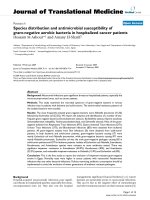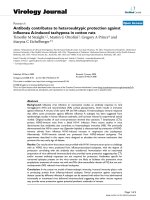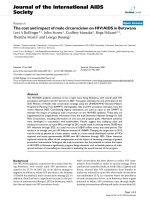báo cáo hóa học:" Fixed point and weak convergence theorems for point-dependent lambda-hybrid mappings in Banach spaces" pot
Bạn đang xem bản rút gọn của tài liệu. Xem và tải ngay bản đầy đủ của tài liệu tại đây (271.46 KB, 33 trang )
This Provisional PDF corresponds to the article as it appeared upon acceptance. Fully formatted
PDF and full text (HTML) versions will be made available soon.
Fixed point and weak convergence theorems for point-dependent lambda-hybrid
mappings in Banach spaces
Fixed Point Theory and Applications 2011, 2011:105 doi:10.1186/1687-1812-2011-105
Young-Ye Huang ()
Jyh-Chung Jeng ()
Tian-Yuan Kuo ()
Chung-Chien Hong ()
ISSN 1687-1812
Article type Research
Submission date 25 August 2011
Acceptance date 23 December 2011
Publication date 23 December 2011
Article URL />This peer-reviewed article was published immediately upon acceptance. It can be downloaded,
printed and distributed freely for any purposes (see copyright notice below).
For information about publishing your research in Fixed Point Theory and Applications go to
/>For information about other SpringerOpen publications go to
Fixed Point Theory and
Applications
© 2011 Huang et al. ; licensee Springer.
This is an open access article distributed under the terms of the Creative Commons Attribution License ( />which permits unrestricted use, distribution, and reproduction in any medium, provided the original work is properly cited.
Fixed point and weak convergence theorems for
point-dependent λ-hybrid mappings in Banach
spaces
Young-Ye Huang
1
, Jyh-Chung Jeng
2
, Tian-Yuan Kuo
3
and Chung-Chien Hong
∗4
1
Center for General Education, Southern Taiwan University, 1 Nantai St., Yongkang
Dist., Tainan 71005, Taiwan
2
Nanjeon Institute of Technology, 178 Chaoqin Rd., Yenshui Dist., Tainan 73746,
Taiwan
3
Fooyin University, 151 Jinxue Rd., Daliao Dist., Kaohsiung 83102, Taiwan
4
Department of Industrial Management, National Pingtung University of Science
and Technology, 1 Shuefu Rd., Neopu, Pingtung 91201, Taiwan
∗
Corresponding author:
Email addresses:
YYH:
JCJ:
TYK:
1
Abstract
The purpose of this article is to study the fixed point and weak convergence
problem for the new defined class of point-dependent λ-hybrid mappings
relative to a Bregman distance D
f
in a Banach space. We at first extend
the Aoyama–Iemoto–Kohsaka–Takahashi fixed point theorem for λ-hybrid
mappings in Hilbert spaces in 2010 to this much wider class of nonlinear
mappings in Banach spaces. Secondly, we derive an Opial-like inequality
for the Bregman distance and apply it to establish a weak convergence
theorem for this new class of nonlinear mappings. Some concrete examples
in a Hilbert space showing that our extension is proper are also given.
Keywords: fixed point, Banach limit, Bregman distance, Gˆateaux differ-
entiable, subdifferential.
2010 MSC: 47H09; 47H10.
2
1 Introduction
Let C be a nonempty subset of a Hilbert space H. A mapping T : C → H is
said to be
(1.1) nonexpansive if T x −Ty ≤ x −y, ∀x, y ∈ C, cf. [1, 2];
(1.2) nonspreading if T x −Ty
2
≤ x −y
2
+ 2 x − T x, y −Ty, ∀x, y ∈ C,
cf. [3–5];
(1.3) hybrid if T x − T y
2
≤ x − y
2
+ x − Tx, y − T y, ∀x, y ∈ C, cf.
[3, 5–7].
As shown in [3], (1.2) is equivalent to
2T x −T y
2
≤ T x −y
2
+ x −T y
2
for all x, y ∈ C.
In 1965, Browder [1] established the following
Browder fixed point Theorem. Let C be a nonempty closed convex subset of
a Hilbert space H, and let T : C → C be a nonexpansive mapping. Then, the
following are equivalent:
(a) There exists x ∈ C such that {T
n
x}
n∈N
is bounded;
(b) T has a fixed point.
The above result is still true for nonspreading mappings which was shown
in Kohsaka and Takahashi [4]. (We call it the Kohsaka–Takahashi fixed point
theorem.)
3
Recently, Aoyama et al. [8] introduced a new class of nonlinear mappings in
a Hilbert space containing the classes of nonexpansive mappings, nonspreading
mappings and hybrid mappings. For λ ∈ R, they call a mapping T : C → H
(1.4) λ-hybrid if T x −Ty
2
≤ x − y
2
+ λ x − Tx, y − T y, ∀x, y ∈ C.
And, among other things, they establish the following
Aoyama–Iemoto–Kohsaka–Takahashi fixed point Theorem. [8] Let C be
a nonempty closed convex subset of a Hilbert space H, and let T : C → C be a
λ-hybrid mapping. Then, the following are equivalent:
(a) There exists x ∈ C such that {T
n
x}
n∈N
is bounded;
(b) T has a fixed point.
Obviously, T is nonexpansive if and only if it is 0-hybrid; T is nonspreading
if and only if it is 2-hybrid; T is hybrid if and only if it is 1-hybrid.
Motivated by the above works, we extend the concept of λ-hybrid from Hilbert
spaces to Banach spaces in the following way:
Definition 1.1. For a nonempty subset C of a Banach space X, a Gˆateaux
differentiable convex function f : X → (−∞, ∞] and a function λ : C → R, a
mapping T : C → X is said to be point-dependent λ-hybrid relative to D
f
if
(1.5) D
f
(T x, T y) ≤ D
f
(x, y) + λ(y) x −Tx, f
(y) −f(T y), ∀x, y ∈ C,
where D
f
is the Bregman distance associated with f and f
(x) denotes the Gˆateaux
derivative of f at x.
In this article, we study the fixed point and weak convergence problem for
4
mappings satisfying (1.5). This article is organized in the following way: Sec-
tion 2 provides preliminaries. We investigate the fixed point problem for point-
dependent λ-hybrid mappings in Section 3, and we give some concrete examples
showing that even in the setting of a Hilbert space, our fixed point theorem gen-
eralizes the Aoyama–Iemoto–Kohsaka–Takahashi fixed point theorem properly in
Section 4. Section 5 is devoting to studying the weak convergence problem for
this new class of nonlinear mappings.
2 Preliminaries
In what follows, X will be a real Banach space with topological dual X
∗
and
f : X → (−∞, ∞] will be a convex function. D denotes the domain of f, that is,
D = {x ∈ X : f(x) < ∞},
and D
◦
denotes the algebraic interior of D, i.e., the subset of D consisting of
all those points x ∈ D such that, for any y ∈ X \ {x}, there is z in the open
segment (x, y) with [x, z] ⊆ D. The topological interior of D, denoted by Int(D),
is contained in D
◦
. f is said to be proper provided that D = ∅. f is called lower
semicontinuous (l.s.c.) at x ∈ X if f(x) ≤ lim inf
y→x
f(y). f is strictly convex if
f(αx + (1 − α)y) < αf(x) + (1 −α)f(y)
for all x, y ∈ X and α ∈ (0, 1).
The function f : X → (−∞, ∞] is said to be Gˆateaux differentiable at x ∈ X
5
if there is f
(x) ∈ X
∗
such that
lim
t→0
f(x + ty) −f(x)
t
= y, f
(x)
for all y ∈ X.
The Bregman distance D
f
associated with a proper convex function f is the
function D
f
: D × D → [0, ∞] defined by
D
f
(y, x) = f(y) −f(x) + f
◦
(x, x − y), (1)
where f
◦
(x, x − y) = lim
t→0
+
f(x + t(x − y)) − f(x)/t. D
f
(y, x) is finite valued
if and only if x ∈ D
◦
, cf. Proposition 1.1.2 (iv) of [9]. When f is Gˆateaux
differentiable on D, (1) becomes
D
f
(y, x) = f(y) −f(x) −y − x, f
(x), (2)
and then the modulus of total convexity is the function ν
f
: D
◦
×[0, ∞) → [0, ∞]
defined by
ν
f
(x, t) = inf{D
f
(y, x) : y ∈ D, y − x = t}.
It is known that
ν
f
(x, ct) ≥ cν
f
(x, t) (3)
for all t ≥ 0 and c ≥ 1, cf. Proposition 1.2.2 (ii) of [9]. By definition it follows
that
D
f
(y, x) ≥ ν
f
(x, y − x). (4)
6
The modulus of uniform convexity of f is the function δ
f
: [0, ∞) → [0, ∞]
defined by
δ
f
(t) = inf
f(x) + f(y) −2f
x + y
2
: x, y ∈ D, x − y ≥ t
.
The function f is called uniformly convex if δ
f
(t) > 0 for all t > 0. If f is
uniformly convex then for any ε > 0 there is δ > 0 such that
f
x + y
2
≤
f(x)
2
+
f(y)
2
− δ (5)
for all x, y ∈ D with x −y ≥ ε.
Note that for y ∈ D and x ∈ D
◦
, we have
f(x) + f(y) −2f
x + y
2
=f(y) − f(x) −
f
x +
y−x
2
− f(x)
1
2
≤f(y) − f(x) −f
◦
(x, y − x) ≤ D
f
(y, x),
where the first inequality follows from the fact that the function t → f(x + tz) −
f(x)/t is nondecreasing on (0, ∞). Therefore,
ν
f
(x, t) ≥ δ
f
(t) (6)
whenever x ∈ D
◦
and t ≥ 0. For other properties of the Bregman distance D
f
,
we refer readers to [9].
The normalized duality mapping J from X to 2
X
∗
is defined by
Jx = {x
∗
∈ X
∗
: x, x
∗
= x
2
= x
∗
2
}
for all x ∈ X.
7
When f(x) = x
2
in a smooth Banach space X, it is known that f
(x) =
2J(x) for x ∈ X, cf. Corollaries 1.2.7 and 1.4.5 of [10]. Hence, we have
D
f
(y, x) = y
2
− x
2
− y − x, f
(x)
= y
2
− x
2
− 2 y − x, Jx
= y
2
+ x
2
− 2 y, Jx.
Moreover, as the normalized duality mapping J in a Hilbert space H is the
identity operator, we have
D
f
(y, x) = y
2
+ x
2
− 2 y, x = y − x
2
.
Thus, in case λ is a constant function and f(x) = x
2
in a Hilbert space, (1.5)
coincides with (1.4). However, in general, they are different.
A function g : X → (−∞, ∞] is said to be subdifferentiable at a point x ∈ X
if there exists a linear functional x
∗
∈ X
∗
such that
g(y) − g(x) ≥ y − x, x
∗
, ∀y ∈ X.
We call such x
∗
the subgradient of g at x. The set of all subgradients of g at x
is denoted by ∂g(x) and the mapping ∂g : X → 2
X
∗
is called the subdifferential
of g. For a l.s.c. convex function f, ∂f is bounded on bounded subsets of Int(D)
if and only if f is bounded on bounded subsets there, cf. Proposition 1.1.11 of [9].
A proper convex l.s.c. function f is Gˆateaux differentiable at x ∈ Int(D) if and
only if it has a unique subgradient at x; in such case ∂f(x) = f
(x), cf. Corollary
1.2.7 of [10].
8
The following lemma will be quoted in the sequel.
Lemma 2.1. (Proposition 1.1.9 of [9]) If a proper convex function f : X →
(−∞, ∞] is Gˆateaux differentiable on Int(D) in a Banach space X, then the
following statements are equivalent:
(a) The function f is strictly convex on Int(D).
(b) For any two distinct points x, y ∈ Int(D), one has D
f
(y, x) > 0.
(c) For any two distinct points x, y ∈ Int(D), one has
x −y, f
(x) −f
(y) > 0.
Throughout this article, F (T ) will denote the set of all fixed points of a
mapping T .
3 Fixed point theorems
In this section, we apply Lemma 2.1 to study the fixed point problem for
mappings satisfying (1.5).
Theorem 3.1. Let X be a reflexive Banach space and let f : X → (−∞, ∞] be
a l.s.c. strictly convex function so that it is Gˆateaux differentiable on Int(D) and
is bounded on bounded subsets of Int(D). Suppose C ⊆ Int(D) is a nonempty
closed convex subset of X and T : C → C is point-dependent λ-hybrid relative to
D
f
for some function λ : C → R. For x ∈ C and any n ∈ N define
S
n
x =
1
n
n−1
k=0
T
k
x,
9
where T
0
is the identity mapping on C. If {T
n
x}
n∈N
is bounded, then every weak
cluster point of {S
n
x}
n∈N
is a fixed point of T.
Proof. Since T is point-dependent λ -hybrid relative to D
f
, we have, for any y ∈ C
and k ∈ N ∪ {0},
0 ≤ D
f
(T
k
x, y) − D
f
(T
k+1
x, T y) + λ(y)
T
k
x −T
k+1
x, f
(y) −f
(T y)
= f(T
k
x) −f(y) −
T
k
x −y, f
(y)
− f(T
k+1
x) + f(T y) +
T
k+1
x −Ty, f
(T y)
+ λ(y)
T
k
x −T
k+1
x, f
(y) −f
(T y)
=
f(T
k
x) −f(T
k+1
x)
+ [f(T y) −f(y)] +
λ(y)(T
k
x −T
k+1
x) −T
k
x + y, f
(y)
+
T
k+1
x −Ty −λ(y)(T
k
x −T
k+1
x), f
(T y)
.
Summing up these inequalities with respect to k = 0, 1, . . . , n −1, we get
0 ≤ [f(x) −f(T
n
x)] + n [f(T y) −f(y)] + λ(y)(x − T
n
x) + ny − nS
n
x, f
(y)
+ (n + 1)S
n+1
x −x − nT y − λ(y)(x −T
n
x), f
(T y).
Dividing the above inequality by n, we have
0 ≤
f(x) − f(T
n
x)
n
+ [f(T y) −f(y)] +
λ(y)(x −T
n
x)
n
+ y − S
n
x, f
(y)
+
n + 1
n
S
n+1
x −
x
n
− Ty −
λ(y)(x −T
n
x)
n
, f
(T y)
. (7)
Since {T
n
x}
n∈N
is bounded, {S
n
x}
n∈N
is bounded, and so, in view of X being
reflexive, it has a subsequence {S
n
i
x}
i∈N
so that S
n
i
x converges weakly to some
v ∈ C as n
i
→ ∞. Replacing n by n
i
in (7), and letting n
i
→ ∞, we obtain from
the fact that {T
n
x}
n∈N
and {f (T
n
x)}
n∈N
are bounded that
0 ≤ f(T y) − f(y) + y − v, f
(y)+ v − T y, f
(T y). (8)
10
Putting y = v in (8), we get
0 ≤ f(T v) − f(v) + v − T v, f
(T v),
that is,
0 ≤ −D
f
(v, T v),
from which follows that D
f
(v, T v) = 0. Therefore T v = v by Lemma 2.1.
The following theorem comes from Theorem 3.1 immediately.
Theorem 3.2. Let X be a reflexive Banach space and let f : X → (−∞, ∞] be
a l.s.c. strictly convex function so that it is Gˆateaux differentiable on Int(D) and
is bounded on bounded subsets of Int(D). Suppose C ⊆ Int(D) is a nonempty
closed convex subset of X and T : C → C is point-dependent λ-hybrid relative
to D
f
for some function λ : C → R. Then, the following two statements are
equivalent:
(a) There is a point x ∈ C such that {T
n
x}
n∈N
is bounded.
(b) F(T ) = ∅.
Taking λ(x) = λ, a constant real number, for all x ∈ C and noting the function
f(x) = x
2
in a Hilbert space H satisfies all the requirements of Theorem 3.2,
the corollary below follows immediately.
Corollary 3.3. [8] Let C be a nonempty closed convex subset of Hilbert space
H and suppose T : C → C is λ-hybrid. Then, the following two statements are
equivalent:
(a) There exists x ∈ C such that {T
n
(x)}
n∈N
is bounded.
11
(b) T has a fixed point.
We now show that the fixed point set F (T ) is closed and convex under the
assumptions of Theorem 3.2.
A mapping T : C → X is said to be quasi-nonexpansive with respect to D
f
if
F (T) = ∅ and D
f
(v, T x) ≤ D
f
(v, x) for all x ∈ C and all v ∈ F (T ).
Lemma 3.4. Let f : X → (−∞, ∞] be a proper strictly convex function on a
Banach space X so that it is Gˆateaux differentiable on Int(D), and let C ⊆ Int( D)
be a nonempty closed convex subset of X. If T : C → C is quasi-nonexpansive
with respect to D
f
, then F (T) is a closed convex subset.
Proof. Let x ∈ F (T ) and choose {x
n
}
n∈N
⊆ F (T) such that x
n
→ x as n → ∞.
By the continuity of D
f
(·, T x) and D
f
(x
n
, T x) ≤ D
f
(x
n
, x), we have
D
f
(x, T x) = lim
n→∞
D
f
(x
n
, T x) ≤ lim
n→∞
D
f
(x
n
, x) = D
f
(x, x) = 0.
Thus, due to the strict convexity of f , it follows from Lemma 2.2 that T x = x.
This shows F (T ) is closed. Next, let x, y ∈ F(T ) and α ∈ [0, 1]. Put z =
αx + (1 −α)y. We show that T z = z to conclude F (T) is convex. Indeed,
12
D
f
(z, T z)
=f(z) − f(T z) −z −T z, f
(T z)
=f(z) + [αf(x) + (1 −α)f(y)] − f(T z) −z − T z, f
(T z)−[αf (x) + (1 − α)f(y)]
=f(z) + α[f(x) − f(T z) −x − T z, f
(T z)]
+ (1 −α)[f(y) − f(T z) −y − T z, f
(T z)] −[αf (x) + (1 − α)f(y)]
=f(z) + αD
f
(x, T z) + (1 −α)D
f
(y, T z) −[αf(x) + (1 − α)f(y)]
≤f(z) + αD
f
(x, z) + (1 −α)D
f
(y, z) − [αf(x) + (1 −α )f (y)]
=f(z) + α[f(x) − f(z) − x −z, f
(z)] + (1 − α)[f(y) − f(z) −y − z, f
(z)]
− [αf(x) + (1 −α)f(y)]
=f(z) + αf(x) − αf(z) − αx −αz, f
(z) + (1 − α)f(y) − (1 − α)f(z)
− (1 −α)y − (1 − α)z, f
(z) −[αf(x) + (1 −α)f (y)]
= −αx + (1 −α)y − (αz + (1 −α)z), f
(z)
= −0, f
(z) = 0.
Therefore, T z = z by the strictly convex of f. This completes the proof.
Proposition 3.5. Let f : X → (−∞, ∞] be a proper strictly convex function on
a reflexive Banach space X so that it is Gˆateaux differentiable on Int(D) and is
bounded on bounded subsets of Int(D), and let C ⊆ Int(D) be a nonempty closed
convex subset of X. Suppose T : C → C is point-dependent λ-hybrid relative to
D
f
for some function λ : C → R and has a point x
0
∈ C such that {T
n
(x
0
)}
n∈N
is
bounded. Then, T is quasi-nonexpansive with respect to D
f
, and therefore, F (T )
13
is a nonempty closed convex subset of C.
Proof. In view of Theorem 3.2, F (T) = ∅. Now, for any v ∈ F (T ) and any
y ∈ C, as T is point-dependent λ-hybrid relative to D
f
, we have
D
f
(v, T y) = D
f
(T v, T y)
≤ D
f
(v, y) + λ(y) v −Tv, f
(y) −f
(T y)
= D
f
(v, y)
for all y ∈ C, so T is quasi-nonexpansive with respect to D
f
, and hence, F (T ) is
a nonempty closed convex subset of C by Lemma 3.4.
For the remainder of this section, we establish a common fixed point theorem
for a commutative family of point-dependent λ-hybrid mappings relative to D
f
.
Lemma 3.6. Let X be a reflexive Banach space and let f : X → (−∞, ∞] be a
l.s.c. strictly convex function so that it is Gˆateaux differentiable on Int(D) and
is bounded on bounded subsets of Int(D). Suppose C ⊆ Int(D) is a nonempty
bounded closed convex subset of X and {T
1
, T
2
, . . . , T
N
} is a commutative finite
family of point-dependent λ-hybrid mappings relative to D
f
for some function
λ : C → R from C into itself. Then {T
1
, T
2
, . . . , T
N
} has a common fixed point.
Proof. We prove this lemma by induction with respect to N. To begin with,
we deal with the case that N = 2. By Proposition 3.5, we see that F (T
1
) and
F (T
2
) are nonempty bounded closed convex subsets of X. Moreover, F (T
1
) is T
2
-
invariant. Indeed, for any v ∈ F (T
1
), it follows from T
1
T
2
= T
2
T
1
that T
1
T
2
v =
T
2
T
1
v = T
2
v, which shows that T
2
v ∈ F (T
1
). Consequently, the restriction of T
2
to F (T
1
) is point-dependent λ-hybrid relative to D
f
, and hence by Theorem 3.2,
14
T
2
has a fixed point u ∈ F (T
1
), that is, u ∈ F (T
1
) ∩F(T
2
).
By induction hypothesis, assume that for some n ≥ 2, E = ∩
n
k=1
F (T
k
) is
nonempty. Then, E is a nonempty closed convex subset of X and the restriction of
T
n+1
to E is a point-dependent λ-hybrid mapping relative to D
f
from E into itself.
By Theorem 3.2, T
n+1
has a fixed point in X. This shows that E ∩F(T
n+1
) = ∅,
that is, ∩
n+1
k=1
F (T
k
) = ∅, completing the proof. .
Theorem 3.7. Let X be a reflexive Banach space and let f : X → (−∞, ∞]
be a l.s.c. strictly convex function so that it is Gˆateaux differentiable on Int(D).
Suppose C ⊆ Int(D) is a nonempty bounded closed convex subset of X and {T
i
}
i∈I
is a commutative family of point-dependent λ-hybrid mappings relative to D
f
for
some function λ : C → R from C into itself. Then, {T
i
}
i∈I
has a common fixed
point.
Proof. Since C is a nonempty bounded closed convex subset of the reflexive
Banach space X, it is weakly compact. By Proposition 3.5, each F (T
i
) is a
nonempty weakly compact subset of C. Therefore, the conclusion follows once
we note that {F (T
i
)}
i∈I
has the finite intersection property by Lemma 3.6. .
4 Examples
In this section, we give some concrete examples for our fixed point theorem.
At first, we need a lemma.
Lemma 4.1. Let h and k be two real numbers in [0, 1]. Then, the following two
statements are true.
15
(a) (h
2
− k
2
)
2
− (h −k)
2
≥ 0, if
h+k
2
> 0.5.
(b) (h
2
− k
2
)
2
− (h −k)
2
≤ 0, if
h+k
2
≤ 0.5.
Proof. First, we represent h and k by
h = 0.5 + a, where − 0.5 ≤ a ≤ 0.5,
and
k = 0.5 + b, where − 0.5 ≤ b ≤ 0.5.
Then, we have
(h
2
− k
2
)
2
− (h −k)
2
= (a − b)
2
(a + b)(a + b + 2).
If
h+k
2
> 0.5, then a + b > 0, and so through the above equation, we obtain
that (h
2
− k
2
)
2
− (h −k)
2
≥ 0. On the other hand,
h+k
2
≤ 0.5 implies a + b ≤ 0,
and hence, (h
2
− k
2
)
2
− (h −k)
2
≤ 0.
Example 4.2. Let C =
x ∈ l
2
(N) : x = (x
1
, x
2
, , x
n
, ), 0 ≤ x
i
≤ 1 −
1
i+1
and δ be a positive number so small that
√
δ < 0.5. Define a mapping T : C → C
by
T x = (T x
1
, T x
2
, . . . , T x
n
, . . . ) : Tx
i
=
x
2
i
, if
√
δ < x
i
≤ 1 −
1
i+1
;
δ, if δ < x
i
≤
√
δ;
x
i
, if 0 ≤ x
i
≤ δ.
Then for any λ ∈ R, T is not λ-hybrid. However, for each x ∈ C, if we let
n
x
= min
n :
∞
i=n+1
x
2
i
≤ δ
2
and define λ : C → R by
16
λ(x) =
1
1
n
x
+1
−
1
(n
x
+1)
2
2
,
then T is point-dependent λ-hybrid, that is,
T x −T y
2
≤ x − y
2
+ λ(y) x −Tx, y − Ty (9)
for all x, y ∈ C. Therefore, we can apply Theorem 3.2 to conclude that T has
a fixed point, while the Aoyama–Iemoto–Kohsaka–Takahashi fixed point theorem
fails to give us the desired conclusion.
Proof. Let x and y be two elements from C so that the m
th
coordinate of x is
1 −
1
m+1
, the m
th
coordinate of y is 0.5 and the rest coordinates of x and y are
zero. We have
T x −T y
2
− x −y
2
− m x − Tx, y − T y
=
1 −
1
m + 1
2
− (0.5)
2
2
−
1 −
1
m + 1
− 0.5
2
− m
1 −
1
m + 1
−
1 −
1
m + 1
2
0.5 −(0.5)
2
=
9
16
−
2
m + 1
+
9
2(m + 1)
2
−
4
(m + 1)
3
+
1
(m + 1)
4
−
m
2
4(m + 1)
2
→
5
16
as m → ∞.
Since the value of above equality is always positive as m is large enough, we
conclude that there is no constant λ to satisfy the inequality:
T x −T y
2
≤ x − y
2
+ λ x − Tx, y − T y
for all x, y ∈ C.
17
It remains to show that T satisfies the inequality (9). We can rewrite the
inequality as
∞
i=1
(T x
i
− Ty
i
)
2
≤
∞
i=1
(x
i
− y
i
)
2
+
∞
i=1
λ(y)(x
i
− Tx
i
)(y
i
− Ty
i
).
Thus, if we can show that for all i ∈ N,
(T x
i
− Ty
i
)
2
≤ (x
i
− y
i
)
2
+ λ(y)(x
i
− Tx
i
)(y
i
− Ty
i
), (10)
then the assertion follows. We prove inequality (10) holds for all i ∈ N by
considering the following two cases: (I) i > min{n
x
, n
y
} and (II) i ≤ min{n
x
, n
y
}.
• Case (I). i > min{n
x
, n
y
}.
In this case, at least one of x
i
and y
i
is less than or equal to δ. Suppose
that 0 ≤ x
i
≤ δ. There are three subcases to discuss.
(I-1): If
√
δ < y
i
≤ 1 −
1
i+1
, then we have
(T x
i
− Ty
i
)
2
= (x
i
− y
2
i
)
2
≤ (x
i
− y
i
)
2
≤ (x
i
− y
i
)
2
+ λ(y)(x
i
− Tx
i
)(y
i
− Ty
i
).
(I-2): δ < y
i
≤
√
δ, then we have
(T x
i
− Ty
i
)
2
= (x
i
− δ)
2
≤ (x
i
− y
i
)
2
≤ (x
i
− y
i
)
2
+ λ(y)(x
i
− Tx
i
)(y
i
− Ty
i
).
(I-3): If 0 ≤ y
i
≤ δ, then we have
(T x
i
− Ty
i
)
2
= (x
i
− y
i
)
2
≤ (x
i
− y
i
)
2
+ λ(y)(x
i
− Tx
i
)(y
i
− Ty
i
).
18
The case that 0 ≤ y
i
≤ δ can be proved in the same manner.
• Case (II). i ≤ min{n
x
, n
y
}.
In this case, there are 9 subcases to discuss.
(II-1):
√
δ < x
i
≤ 1 −
1
i+1
and
√
δ < y
i
≤ 1 −
1
i+1
.
If
x
i
+y
i
2
≤ 0.5, it follows from Lemma 4.1 that
(T x
i
− Ty
i
)
2
= (x
2
i
− y
2
i
)
2
≤ (x
i
− y
i
)
2
≤ (x
i
− y
i
)
2
+ λ(y)(x
i
− Tx
i
)(y
i
− Ty
i
).
If
x
i
+y
i
2
> 0.5, then both x
i
and y
i
are greater than
1
i+1
, and so by
considering the graph of the function g(z) = z − z
2
in R, which is
symmetric to the line L : x = 0.5, we have
x
i
− x
2
i
≥
1
i + 1
−
1
i + 1
2
≥
1
n
y
+ 1
−
1
n
y
+ 1
2
and
y
i
− y
2
i
≥
1
i + 1
−
1
i + 1
2
≥
1
n
y
+ 1
−
1
n
y
+ 1
2
.
Consequently, we obtain
(T x
i
− Ty
i
)
2
=
x
2
i
− y
2
i
2
≤ 1 ≤
1
1
n
y
+1
−
1
(n
y
+1)
2
2
(x
i
− x
2
i
)(y
i
− y
2
i
)
≤ (x
i
− y
i
)
2
+ λ(y)(x
i
− Tx
i
)(y
i
− Ty
i
).
(II-2): δ < x
i
≤
√
δ and
√
δ < y
i
≤ 1 −
1
i+1
.
19
If y
i
≤ 0.5, then
x
i
+y
i
2
< 0.5. Thus, from Lemma 4.1, we have
(T x
i
− Ty
i
)
2
= (δ − y
2
i
)
2
≤ (x
2
i
− y
2
i
)
2
≤ (x
i
− y
i
)
2
≤ (x
i
− y
i
)
2
+ λ(y)(x
i
− Tx
i
)(y
i
− Ty
i
).
If y
i
> 0.5, we have either
δ < x
i
≤ δ +
1
i + 1
−
1
i + 1
2
or
δ +
1
i + 1
−
1
i + 1
2
< x
i
≤
√
δ.
When δ < x
i
≤ δ + (
1
i+1
) − (
1
i+1
)
2
, by considering the graph of the
function g(z) = z − z
2
in R, we have
y
i
− y
2
i
≥
1
i + 1
−
1
i + 1
2
≥ x
i
− δ.
and thus, we obtain
y
i
− x
i
≥ y
2
i
− δ > 0.
Therefore,
(T x
i
− Ty
i
)
2
=(δ − y
2
i
)
2
≤(x
i
− y
i
)
2
≤ (x
i
− y
i
)
2
+ λ(y)(x
i
− Tx
i
)(y
i
− Ty
i
).
When δ+
1
i+1
−
1
i+1
2
< x
i
≤
√
δ, both of x
i
−δ and y
i
−y
2
i
are greater
than
1
i+1
−
1
i+1
2
and thus also greater than
1
n
y
+1
−
1
n
y
+1
2
.
20
Therefore,
(T x
i
− Ty
i
)
2
= (δ − y
2
i
)
2
≤ 1 ≤
1
1
n
y
+1
−
1
(n
y
+1)
2
2
(x
i
− δ)(y
i
− y
2
i
)
≤ (x
i
− y
i
)
2
+ λ(y) (x
i
− Tx
i
) (y
i
− Ty
i
) .
21
Likely, we can prove the case:
(II-3):
√
δ < x
i
≤ 1 −
1
i+1
and δ < y
i
≤
√
δ.
(II-4): 0 ≤ x
i
≤ δ and
√
δ < y
i
≤ 1 −
1
i+1
.
Then, we have
(T x
i
− Ty
i
)
2
= (x
i
− y
2
i
)
2
≤ (x
i
− y
i
)
2
≤ (x
i
− y
i
)
2
+ λ(y)(x
i
− Tx
i
)(y
i
− Ty
i
).
Similarly, we can prove the case:
(II-5):
√
δ < x
i
≤ 1 −
1
i+1
and 0 ≤ y
i
≤ δ.
(II-6): δ < x
i
≤
√
δ and δ < y
i
≤
√
δ.
In this case, we have
(T x
i
− Ty
i
)
2
= (δ − δ)
2
= 0 ≤ (x
i
− y
i
)
2
+ λ(y)(x
i
− Tx
i
)(y
i
− Ty
i
).
(II-7): 0 ≤ x
i
≤ δ and δ < y
i
≤
√
δ.
This case can be treated as (I-2).
(II-8): 0 ≤ x
i
≤ δ and 0 ≤ y
i
≤ δ.
This case can be treated as (I-3).
(II-9): δ < x
i
≤
√
δ and 0 ≤ y
i
≤ δ.
This case can be treated as (I-2).
To end this section, we give another example which shows that the concept
of a nonspreading mapping in the sense of (1.2) is generally different from that
of a 2-hybrid mapping relative to some D
f
in Hilbert spaces.
22
Example 4.3. Define f : R → R by f(x) = x
10
for all x ∈ R, and define
T : [0, 0.85] → [0, 0.85] by T x = x
2
for all x ∈ [0, 0.85]. Then, T is neither
nonexpansive nor nonspreading, but it is λ-hybrid relative to D
f
for any λ ≥ 0.
Thus, we can apply Theorem 3.2 to conclude T has a fixed point, while both of the
Browder Fixed Point Theorem and the Kohsaka–Takahashi fixed point theorem
fail.
Proof. It is easy to check that T is not nonexpansive. As for not nonspreading,
taking x = 0.85 and y = 0 .5, we have
T x −T y
2
= (x
2
− y
2
)
2
=
(0.85)
2
− (0.5)
2
2
= 0.22325625
while
x −y
2
+ 2 x − Tx, y − T y
=(x −y)
2
+ 2(x −x
2
)(y − y
2
)
=(0.85 −0.5)
2
+ 2
0.85 −(0.85)
2
0.5 −(0.5)
2
= 0.18625.
Hence, T is not nonspreading in the sense of (1.2). It remains to show that for
any λ ≥ 0, T is λ-hybrid relative to D
f
. Note at first that, for all λ ≥ 0 and for
all x, y ∈ [0, 0.85],
λ x − T x, f
(y) −f
(T y)
=λ
x −x
2
10y
9
− 10y
18
≥ 0.
Hence, it suffices to prove that T is 0-hybrid relative to D
f
, that is, to show that
D
f
(T x, T y) −D
f
(x, y) ≤ 0, ∀x, y ∈ [0, 0.85].
23
Fixed any x ∈ [0, 0.85], let h(y) = D
f
(T x, T y) −D
f
(x, y). Then
h(y) = f (T x) − f(T y) − T x −Ty, f
(T y) −[f(x) −f(y) − x − y, f
(y)]
= x
20
+ 9y
20
− 10x
2
y
18
− x
10
− 9y
10
+ 10xy
9
.
We have
h
(y) = 180y
19
− 180x
2
y
17
− 90y
9
+ 90xy
8
= 90y
8
2y
11
− 2x
2
y
9
− y + x
= 90y
8
2y
9
(y
2
− x
2
) −(y − x)
= 90y
8
2y
9
(y + x)(y − x) −(y − x)
= 90y
8
(y − x)
2y
9
(y + x) −1
.
Since y and x are in [0, 0.85], one has
2y
9
(y + x) −1 < 2(0.85)
9
(0.85 + 0.85) −1 < 0,
and hence
h
(y)
≥ 0 , if y ≤ x;
≤ 0 , if y > x.
Moreover, we know h(y) = 0 if x = y. Therefore, h(y) is always less than or equal
to zero and we have proved that D
f
(T x, T y)−D
f
(x, y) ≤ 0 for all x, y ∈ [0, 0.85].
5 Weak convergence theorems
In this section, we discuss the demiclosedness and the weak convergence prob-
24









